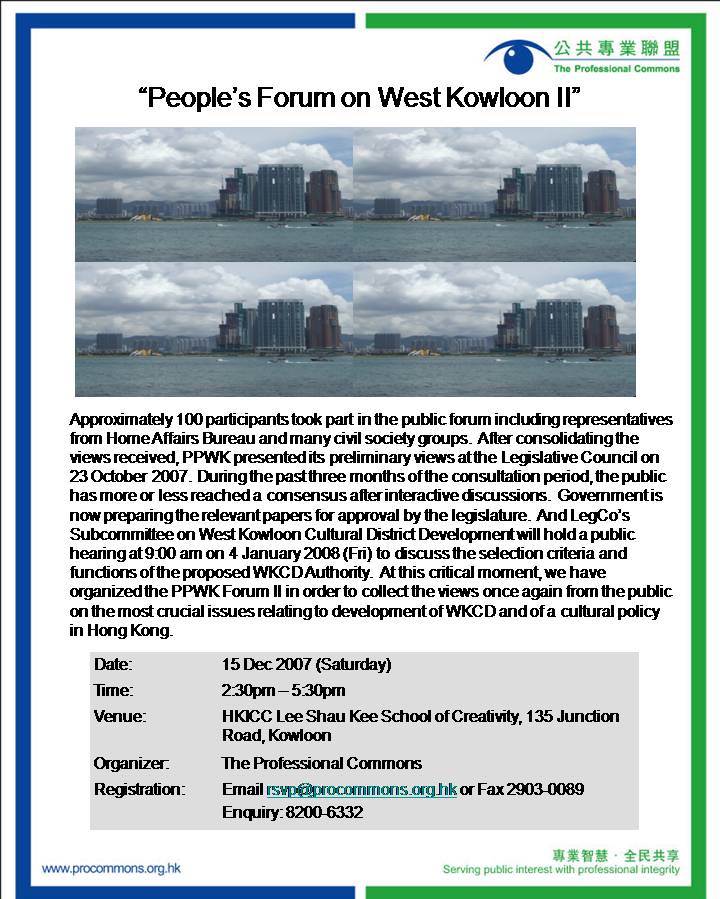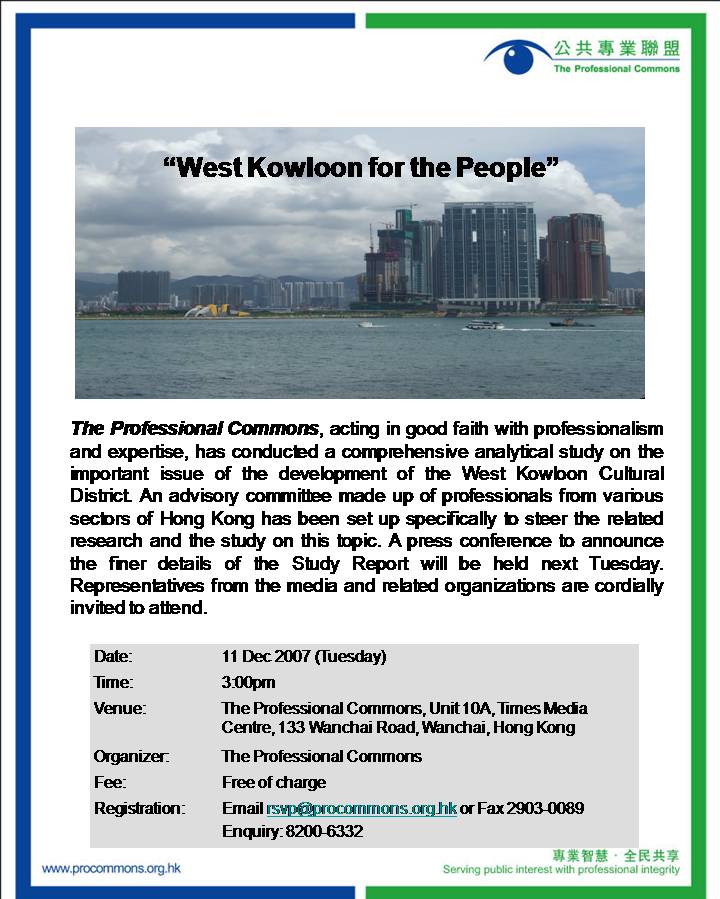Event
Report
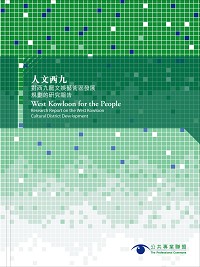
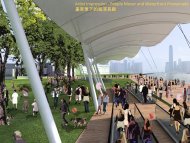
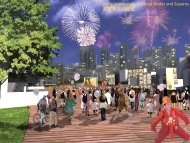
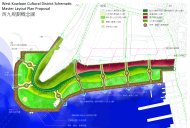
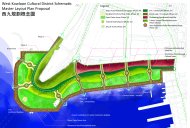
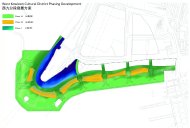
“A West Kowloon for the People”
Research Report on the West Kowloon Cultural District Development
Executive Summary
1. The Government of the Hong Kong Special Administrative Region (the Government) published the Recommendation Report of the Consultative Committee on the Core Arts and Cultural Facilities of the West Kowloon Cultural District (the West Kowloon Report) in September this year, followed by a three-month public consultation period initiated by the Home Affairs Bureau. The West Kowloon Cultural District project is an important turning point for the development of Hong Kong’s culture and arts by leads and bounds. Besides, the location of West Kowloon is also important as it is situated at Victoria Harbour. Therefore, The Professional Commons (The ProCommons) is highly concerned about the recommendations as suggested in the West Kowloon Report.
2. On such an important issue as the West Kowloon project, The ProCommons, acting in good faith with professionalism and expertise, has conducted an analytical study on it and set up an advisory group to steer the study. To facilitate our study, we have conducted professional exchanges with those who were concerned about the West Kowloon project so as to solicit their valuable insights. On 23 October, representatives of The ProCommons attended a meeting held by the Subcommittee on West Kowloon Cultural District Development of the Legislative Council to express our initial views on the West Kowloon Report in respect of development mix and planning standards. After the completion of the in-depth study, The ProCommons is of the opinion that there is room for improvement with regard to the recommendations put forward by the West Kowloon Report, involving not only the views on specific facilities within the district, but also the fundamental planning principles which should have incorporated more forward looking elements. In view of this, we have prepared this research report on the West Kowloon project and put forth our proposals for planning and cultural policies for public consideration. We also hope that the Government will carefully consider and accept our proposals with broadmindedness.
3. We suggest that the Government should adopt a “West Kowloon for the People” approach in developing the district. To develop a “West Kowloon for the People”, we need to adopt a “people orientated” approach and a global outlook, rather than a sheer demonstration of political resoluteness. We think that the Government should get rid of the traditional governing mentality and the rigid fiscal policy of self-sufficiency. It would be important to take into consideration the well-being of people and develop West Kowloon into a well-planned site for public enjoyment. We should turn West Kowloon into a catalytic force behind the development of local culture or even the development of an overall integrated culture. More factors concerning sustainable development should be injected into the project so that the quality of life in Hong Kong, apart from the materialistic one, could be enhanced, thus making the territory a truly high-grade metropolis. We coin the term a “West Kowloon for the People” to generalize the rationale for development in the area. The specific planning concepts and strategies were covered in our research report in detail.
4. We consider that the three recommendations for the West Kowloon project initiated by the Culture and Heritage Commission (CHC) in 2003 and the Harbour Planning Guidelines (HPG) put forward by the Harbour-front Enhancement Committee have provided a more macro outlook and thus better representing the people’s principles. These principles could therefore supplement the deficiencies of the West Kowloon Report. We agree to the principles initiated by the CHC and the HPG, and have incorporated them in our proposals for the West Kowloon project. In sum, The ProCommons suggests that the Government should put into effect the concept of a “West Kowloon for the People” by the following means:
A. Expansion of open area for the release of free creativity
5. To refine the development mix, private residential development would be reduced by one-third and communal facilities, for example, fire service complex, be removed. By so doing, 14 000 square meters of open space can be released. A “creativity jam” (創意交流村) with an area of 5 000 square meters can also be provided. In addition, our proposal may bring in an additional fund of HK$1.5 billion for promoting cultural development on district level.
B. Forward-looking low carbon development mode
6. West Kowloon should be developed into a “low carbon demonstrative zone”, we could show the world our commitment to the environment. Specific measures include installing moving walkways as major transport means within the area and to encourage visitors to stroll in the area, setting up cycling networks connecting new and established areas, designating pedestrian zones during daytime, adopting district cooling systems, enforcing higher energy efficiency standards in buildings, etc. It is advisable that a public design competition be held for the West Kowloon development plan so as to pool the wisdom of the masses and achieve the world’s highest standards.
C. Optimum use of resources and organic growth
7. Taking into consideration the optimum use of resources, nurturing of talents and building a people’s foundation for development, the current phasing development of the West Kowloon project should be further divided, with small scale or even temporary performance areas, for example, black box theatres and open air performance areas, etc., coming into being by the end of 2012 to accommodate street performers as well as small-scale “people’s arts fairs” (民眾藝墟), in addition to landscaped parks to be built earlier for public enjoyment. By so doing, members of the public may enjoy at least part of the West Kowloon Cultural District two years ahead of schedule. Land neighbouring the arts fairs should be reserved for future expansion. If necessary, land reserved for phase II expansion may also be used for providing temporary cultural performance facilities, for example, Cantonese Opera theatres, circus marquees, etc. As regards the construction work of large-scale arts facilities, it should generally follow the original schedule.
D. Blending of nature and culture
8. The open space inside the cultural district should be made green to the largest extent to facilitate the setting up of a “West Kowloon Park”. The whole park belt should include a central park of considerable size, a harbour-front promenade, cycling paths, and different areas inside the belt should be connected by a network of moving walkways and walking trails. With landscaped areas, installation arts and street performances, the whole park belt would be teemed with vivacious activities, creating an atmosphere of natural scenery permeated by and blended with arts.
E. Leap Beyond West Kowloon and be rooted locally
9. To avoid turning West Kowloon to be an “isolated cultural island”, we must at the same time build “community cultural networks” (社區文化網絡) across the territories. It would be of particular importance to set up “community cultural centres” (社區文化中心) on district level to provide cultural development venues on the middle level. In terms of the development of cultural hardware, the Government should first invest in areas comparatively lacking cultural and arts facilities such as the northwest New Territories and Tseung Kwan O, where further cultural centres and performance venues should be built, and idle premises be revitalized for cultural and arts purposes. The HK$1.5 billion additional revenue from land sale could be used for the setting up of a “district cultural development fund” (地區文化發展基金) to promote long-term programmes of stationing performing troupes or artists in venues for performing arts or at schools, or to promote sustainable cultural activities in remote areas such as Tin Shui Wai. In this respect, the “creativity jam” in West Kowloon could be used for linking the West Kowloon Cultural District with local culture in a bid to tap the essence of district-based culture.
10. Our last but important recommendation to make is that the composition and operation of the West Kowloon Cultural District Authority as proposed by the West Kowloon Report would be a major determinant on whether the proposition of “A West Kowloon for the People” could be materialized. Although this issue is outside the scope of our study, the ProCommons still finds it necessary to exemplify our views. The composition of the West Kowloon Cultural District Authority should follow the “stakeholder-led” principle whereby membership of the Authority should be diversified and it should comprise not only appointees of the Government but also those who are chosen by concern groups so as to strike a prudent balance among all stakeholders, be they were government officials, professionals, individuals in the cultural sectors, members of the public and representatives from non-government organizations.

